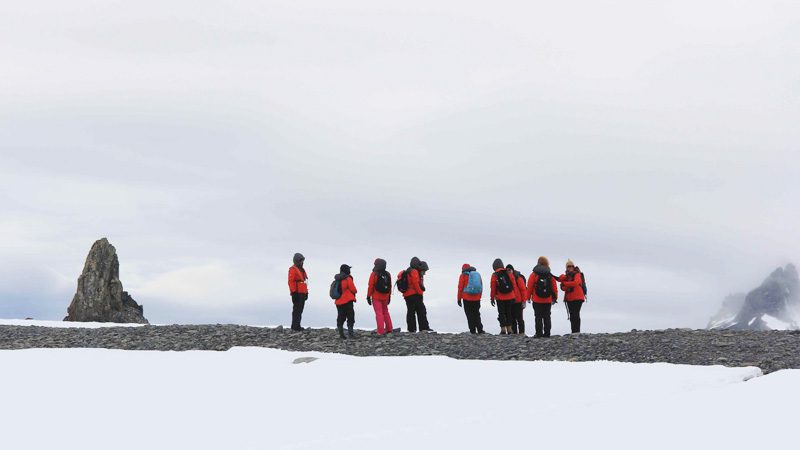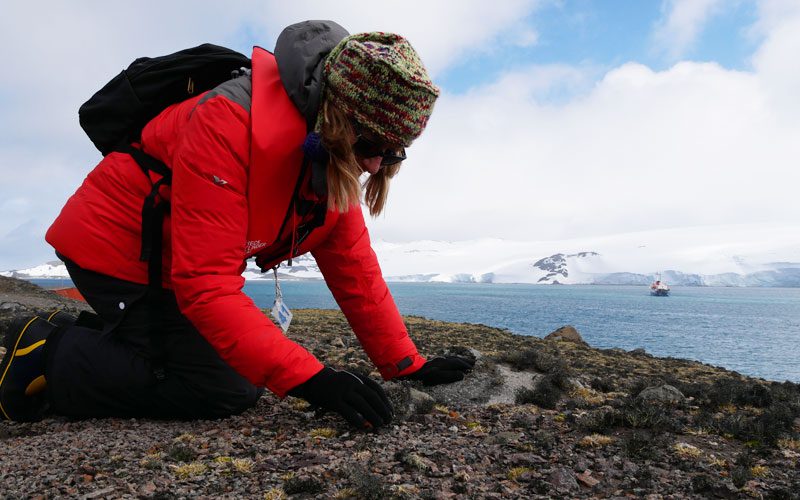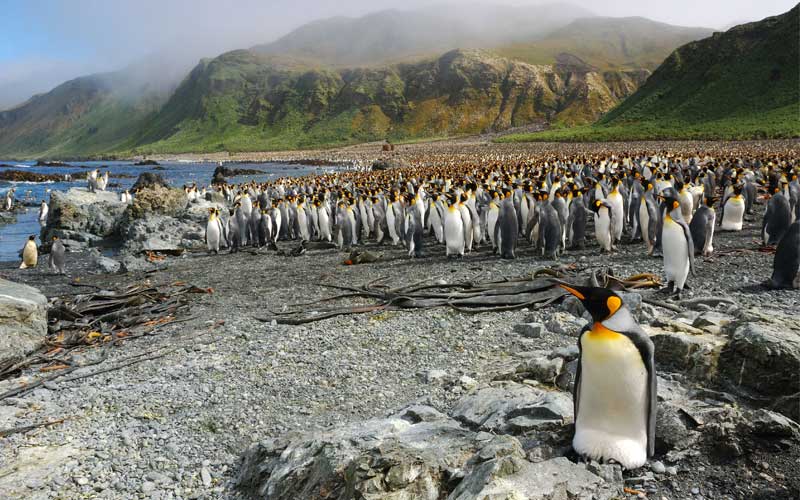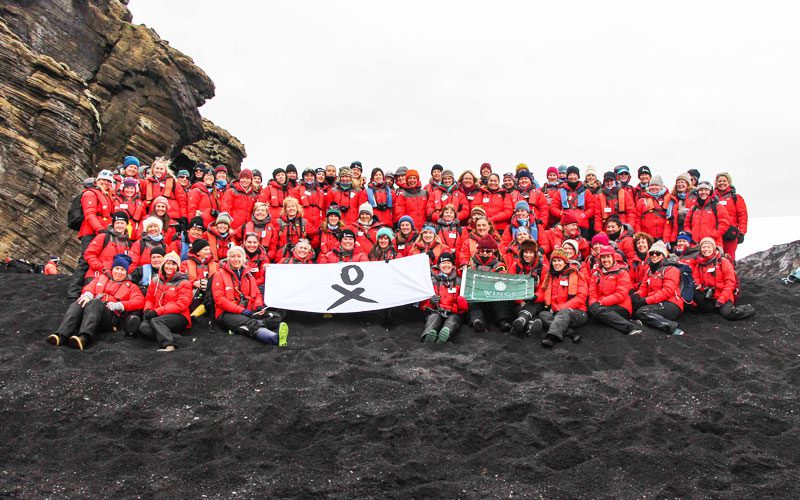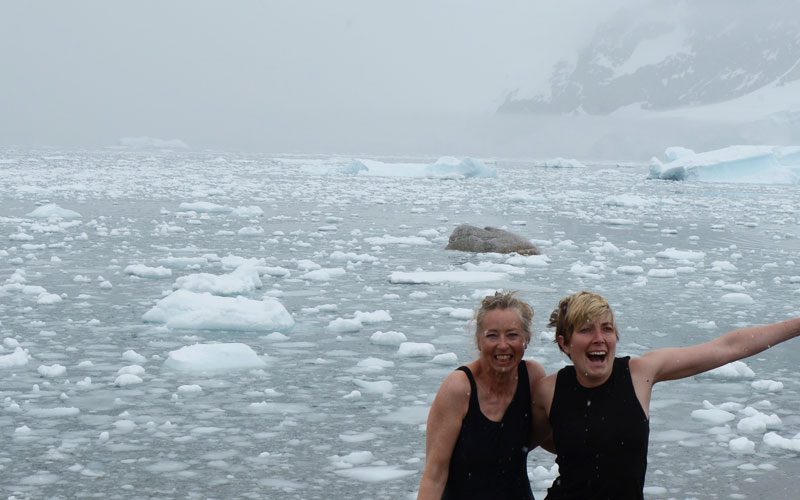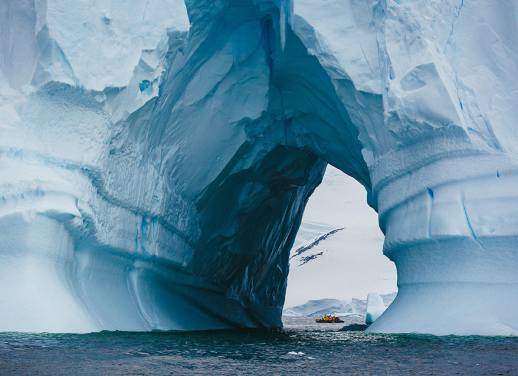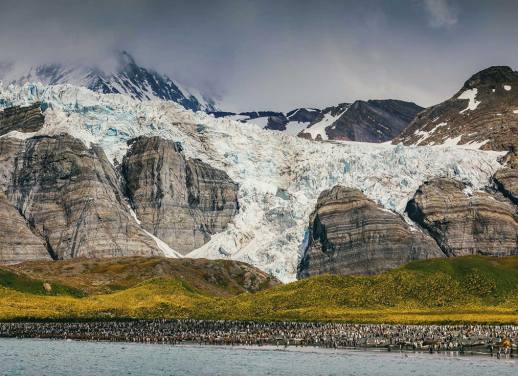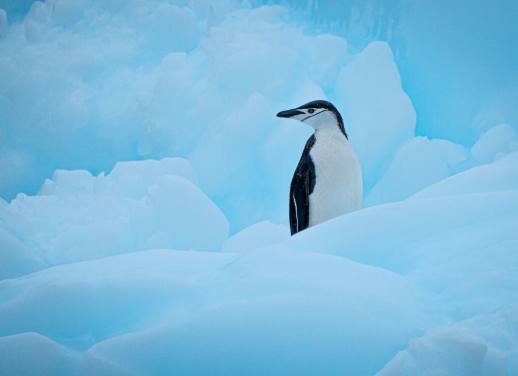Last year, 77 female scientists set out for the Antarctic peninsula – the biggest all-women expedition ever attempted. It’s all part of a project called Homeward Bound: a scientific collective of women from all over the world who ventured to the world’s coldest, driest continent to raise awareness on the low representation of women in leadership and their potential contribution to policy and decision making, particularly on issues like climate change. It’s the brainchild of Australian leadership activist Fabian Dattner, and Research Scientist at the Australian Antarctic Division, Jess Melbourne-Thomas.
“Homeward Bound came about because of a dream,” Fabian says. “What inspired the dream? Frustration with what I know is happening with women in leadership generally, and then an increasing concern in science, at women’s absence at the decision table. Science touches every part of our world as it is and will be. I believe you need the best possible people at the leadership table and women need to be 50% of that – at the moment, on average globally they are between 9%”
The expedition, which set out in 2016, was a massive success, and plans are already underway for the next venture in February 2018 (again to Antarctica).
We sat down with Fern Hames, one of the 77 women who joined the inaugural expedition, to chat about women in leadership, the Homeward Bound project, and what they found in the wilds of Antarctica…
1. What’s your background? How did you get involved in Homeward Bound?
I’ve been just a little bit obsessed with Antarctica since I did my Honours project, as part of my science degree, on Antarctic algae. I studied my supervisor’s samples, but I desperately wanted to go ‘south’. I applied a few times in the early ’80s, but was advised that ” there are no facilities for women”. So after a while, I gave up, and put that dream away. I continued to read about Antarctica, for three decades, while I took a different research path (on freshwater fish). I worked in environmental education and science communication, and became very interested in effective leadership, along with gender equity.
When I saw Homeward Bound advertised, I was thrilled – it brought together these three passions of mine, around Antarctica, leadership, and women’s voices in science. I applied, with a kind of excited tightness in my chest, just thinking about how completely awesome it would be to actually get in.
2. Were you nervous before the journey?
Quite often, before I’m about to travel somewhere, it doesn’t seem quite real until I’m actually on the way. This journey was very much like that. There was a long lead-up to Homeward Bound’s Antarctic journey; about a year, with a lot of preparation. Over that time I read voraciously, worked with a small team of others on a project, joined online conference calls, and completed a bunch of leadership diagnostic tools. You’d think, with all that, that the place would be very solidly in my head, but Antarctica is such a different environment it still didn’t seem real. I did wonder if my hands would cope with the cold – they go numb when I ski at Mt Buller in Victoria; how would I manage my camera in Antarctica?
3. Why is it important for women to get involved in science and conservation?
That’s a bit like asking ‘why is it important for people to get involved in science and conservation’. We are at an extraordinary time in history. It feels as though our planet is teetering on a tipping point. For most of my science career I felt as thought we were gradually progressing; growing our knowledge and improving our conservation efforts. But just recently, things have shifted, and it feels as though many of the advances we have made have been pushed back, way back. It is a crucial time to be using all the very best science, information, knowledge and wisdom we can find in the world. It would simply be really weird to expect we would only find that in one gender. We are facing truly ‘wicked problems’ so we need the very best ideas and voices around the decision making table, and we need to consider multiple perspectives – women must be part of this. Many people also believe that women have particularly strong skills in a collaborative approach; a collaborative, multi-disciplinary, trans – disciplinary approach is necessary to respond to the complex issues we face in science and conservation today.
4. What was the biggest challenge
Antarctica is an absolutely awesome place, in the truest sense of the word. I was in awe, every day. Sometimes, I found myself simply overcome at how overwhelmingly beautiful, raw and abundant the place was. Often, I found myself thinking: “I am really here. I am actually in Antarctica. I am actually surrounded by 100,000 penguins”. I was stunned at how these enormous vistas were so empty of people and so abundant with wildlife. I kept thinking : “So this is what an ecosystem looks like without human impacts” (well; apart form that very evident climate change thing…). And for me, I need to process those things. It was a challenge to process this awe while being so busy with leadership and strategy sessions and landings over really long days (it never got dark!). I treasured still, quiet moments of contemplation. And the busy program also meant it was a challenge to find the opportunity to have a really full conversation with everyone; there were so many extraordinary women on the ship and I feel like I didn’t make the most of properly getting to know them all.
Of course, the full program meant we did so much, so it was fantastic to pack in what we could. And what it has meant afterwards, now, is that I am slowly processing it in the weeks and months since, still. I am processing it as I go over my photos, as I share Facebook posts with the other Homeward Bounders, as I talk about it with my friends, as we chat right now. And I am getting to know more of the other women, as well; the ship was just the start. So my Homeward Bound journey is not over; it has become a part of me, and will continue to shape my view of the world from here on. The world has shifted, and continues to shift, as I progressively explore more pieces of our journey.
Hearing, and directly seeing, the climate change story right in front of us was confronting. Hearing the multiple challenges of people working in this area was confronting. It’s a challenge to find effective ways to progress. Homeward Bound can be powerful here, but it has opened our eyes to some of the deeper complexities and challenges.
5. Tell us about your fellow scientists and explorers
For me, the highlights of Homeward Bound were the place and the people. Most people know something about the awesomeness of Antarctica. The people – oh my goodness! I met women who are smart and funny and wise and kind and hilarious. I met women who are UN negotiators in climate change and biodiversity, a Dean of Engineering, a Professor in Plant Science, an Associate Professor in Public Policy. I met meteorologists, physicists, geologists, microbiologists and science communicators (and more). I met a Penguin Lady, a forest activist, and folk from Doctors without Borders. I met knitters and crocheters, yoga devotees and musicians. These are women who have deep integrity, conviction, ethics, knowledge, skill and expertise. To be honest, I really am confident that we can, indeed we are, reshaping leadership, around the world. The leadership team and crew were also extraordinary. I adored Monika Schillat’s unique style and stories about Antarctica. I have learned much from Greg Mortimer’s daily “Good morning possums”; genuine, thoughtful and graceful leadership; gorgeous humanity and deep knowledge of Antarctica. I will never forget Captain Waldemar Wichmann’s beautiful balance of stories, authority, humour and openness. I met thinkers and doers. I met people who knew who to have fun, and how to have great conversations. I met people who care. I met my new, amazing friends. How lucky am I?!
6. Was Homeward Bound a success? What’s the next step?
Homeward Bound was an extraordinary success. There are many ‘next steps’ for those on the inaugural voyage. Clusters of women are working together collaboratively. We are all sharing knowledge, experience and tools, we’re supporting each other in a huge range of ways, and we will continue to grow our voices, and hopefully our influence, in our own contexts and, collectively, globally. For Homeward Bound, a second group has been selected for Homeward Bound 2018, and those women are now beginning their own journey. Over the next decade, as each journey develops, and each group has their own Homeward Bound experience, we grow a stronger collective voice and increased influence.
7. How can ordinary people get involved?
Everyone can be part of this. Everyone can be part of the Homeward Bound story and journey. If you are a woman with a background in science, you can apply to join one of the journeys; the plan is to deliver a decade of these. If you are interested in hearing about our adventures on the ice, or seeing our amazing photo or videos, or thinking about our ideas around leadership, you can follow the Homeward Bound blogs and the various online posts of participants. Join us vicariously and dream of Antarctica. You can also support individuals through their crowdfunding efforts; for our group the opportunities included buying crocheted penguins named after each expeditioner and which travelled with us, buying books authored by expeditioners, sponsoring a ‘Polar Plunge’, lining up a post-voyage leadership presentation to your work place, or even just receiving a post card from Antarctica.
If you have the means, you might like to consider completely sponsoring someone to participate; Homeward Bound is keen to ensure each group of women is diverse, and that means we really need some support to make that possible. Connect with a ‘Homeward Bounder’ and ask them to present to your team or community; it might start a really terrific conversation. Everyone can be part of doing things differently; share the story; influence leadership and inclusiveness in your own sphere, mainstream a more collaborative way to lead, mainstream properly valuing and caring for nature, mainstream living a more sustainable life. Join us; make a difference. And look out for the documentary film! (I cried just watching some of the film crew’s footage; I am in absolute awe at what they have captured).
8. When you look back on the adventure, what stands out?
The people and the place have had an enormous impact on me. One of the unexpected highlights (and there were many) was swimming. I never expected to go swimming in Antarctica. I knew some of the women were doing a ‘Polar Plunge’ as part of their crowdfunding campaigns, and when a few of them did that at Deception Island I helped them with towels and dry socks and taking photos. It was only then that I thought I could do that, and that it was something I would probably never get the chance to do again – and I love exploring the ‘extremeness’ of places. So I was prepared, with my bathers on under my five layers of thermals, ski gear, jacket etc, when we landed at Neko Harbour. It was snowing; huge slow fat snowflakes silently drifting down and there was a kind of muffled, quiet, gentle stillness to the day. There was also a glacier just a little further along the bay; regular distant thunder- like booming sounds heralded ice constantly calving into the bay, this new sea ice created its own little displacement ‘wake’ in the form of very tiny waves easing up and down the tideline. We were directed to keep off a large section of the pebbly beach, where a larger tsunami-like wave could suddenly rush up onto the shore; it had happened before, and we heard stories of men, and zodiac boats, being swept out. At the safer section of shore, a few penguins waddled nearby as Sarah and I stripped off all our warm layers and put them on the rocks. The sea was covered with patches and chunks of ice. Before we could reconsider, we ran in, dipped in, and I realised I could barely breathe.
I turned to swim and wade back, and it was like trying to swim in a giant ice slurry or slushie. It was much more difficult than I’d expected, and I also remember thinking “so this is probably what serious asthma feels like…”. Adrenalin racing through us, we shrieked, laughed, ran out, and grabbed our towels; more laughing, shrieking and gasping. We then noticed we had blood trickling down our legs; the ice had cut our legs as we ran in. and we had a mass of horizontal cuts on our legs. We dabbed it away, quickly got dressed and climbed back on a zodiac to head back to the ship. It was exhilarating. It was one of the best things I’ve ever done. I felt so completely, hugely, vibrantly, alive.
Want to learn more about Homeward Bound and how you can get involved? Check our their homepage or follow them on Instagram. If you want to venture to Antarctica with Intrepid, have a look at out small group adventures.
Images c/o Homeward Bound

